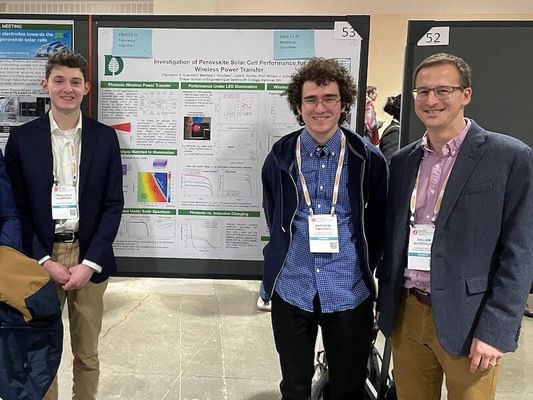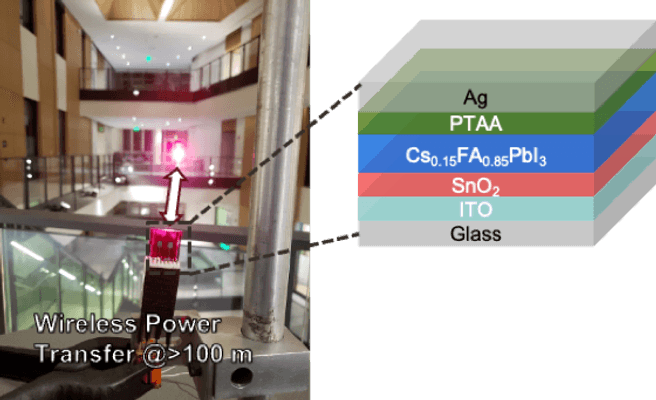- Undergraduate
Bachelor's Degrees
Bachelor of ArtsBachelor of EngineeringDual-Degree ProgramUndergraduate AdmissionsUndergraduate Experience
- Graduate
Graduate Experience
- Research
- Entrepreneurship
- Community
- About
-
Search
All Thayer News


Wireless power transfer for a more sustainable Internet of Things
Dartmouth Engineering Undergraduates Lead Research on Wireless Power Transfer
Nov 01, 2023 | by Catha Mayor
Engineering sciences majors Matthew Timofeev '25 and Vann Guarnieri '21 Th'22 are first authors on a study published last week in Applied Physics Letters (APL) Energy. The paper, titled "Engineering perovskite solar cells for efficient wireless power transfer," presents a method for powering electronic devices with a beam of light, eliminating the need for wires or batteries.

Vann Guarnieri '21 Th'22, Matthew Timofeev '25, and Professor William Scheideler (l to r) presenting at last fall's Materials Research Society meeting in Boston.
"This project was started in Spring 2020 by Vann and wrapped up in Spring 2023 by Matthew," says Professor William Scheideler who is also an author on the study along with PhD candidate Julia Huddy. "It is rare for any undergrad-led work to actually get published, so it's nice to acknowledge their hard work."
Guarnieri and Timofeev met and began their collaboration in Scheideler's Scalable Energy and Nanomaterial Electronics (SENSE) Lab.
"I've been working in Professor Scheideler's SENSE Lab since freshman year," says Timofeev. "I emailed a few professors whose projects aligned with my interests in clean energy engineering and systems thinking, and he got back to me. He wanted to show me around, so I came to some lab meetings and it seemed very interesting. And he was cool with letting me contribute, so I'm really thankful for that.
"I'm interested in having research be a part of my career, especially when it comes to energy technology because for the energy transition, you're going to need everything and the kitchen sink. For this study, the idea is, if you can't have wires or batteries, you could power devices entirely optically—with monochromatic light for the highest efficiency. It could improve the sustainability aspect of powering devices in general, and could be one of the methods to reduce the e-waste stream.
"Vann was instrumental in starting this project, and then Professor Scheideler asked me to help out with getting it to completion. The amount of work it takes to get a paper through, it's almost as hard as Congress passing a budget resolution! It's making sure, do I understand it, and is there a clear bridge from my understanding to somebody else's understanding? That's really the goal of the paper."
The paper was also promoted as editor's pick for a "Scilight":

Matthew Timofeev '25 conducted a 100-meter prototype test in the atrium of Dartmouth's Engineering and Computer Science Center. (Image by Matthew Timofeev)
Wireless power transfer for a more sustainable Internet of Things
Adapted with permission from Scilight 2023, 431106.
As the Internet of Things (IoT) expands, so too does its demand for power. Currently, many devices in the IoT network rely on single-use batteries that can be difficult to replace for remote or sensitive sensors and clog up landfills.
Perovskite solar cells, best known for their use in solar panels, can also assist in photonic wireless power transmission when coupled with a monochromatic light source. Timofeev et al. demonstrated how such a setup could work, providing sufficient power by shining a laser over 100 meters away from the detector.
This undergraduate-led effort identified the potential of perovskites for this unconventional purpose.
"Perovskites have many of the necessary capabilities to help solve this problem of sustainability through an energy harvesting approach," said Scheideler. "They are compatible with large area, low-cost manufacturing methods such as printing that could allow fabrication of these devices on flexible substrates. Perovskites also have tunable bandgap energies and can offer high-efficiency conversion for monochromatic light."
The authors fabricated their perovskite cells using conventional spin-coating methods as well as high-speed printing methods. They measured the power produced from LEDs and lasers of varying wavelengths, intensities, and at varying distances. Even at distances greater than 100 meters, the authors achieved efficient energy conversion capable of powering an IoT device.
"We are targeting applications of our devices in powering wireless sensor networks, particularly those installed in the built environment in locations that make changing batteries infeasible, such as on ceilings or in cleanrooms," said Scheideler. "These sensors could be placed in new locations and could operate for longer durations using power provided by photonic power transfer."
For contacts and other media information visit our Media Resources page.
